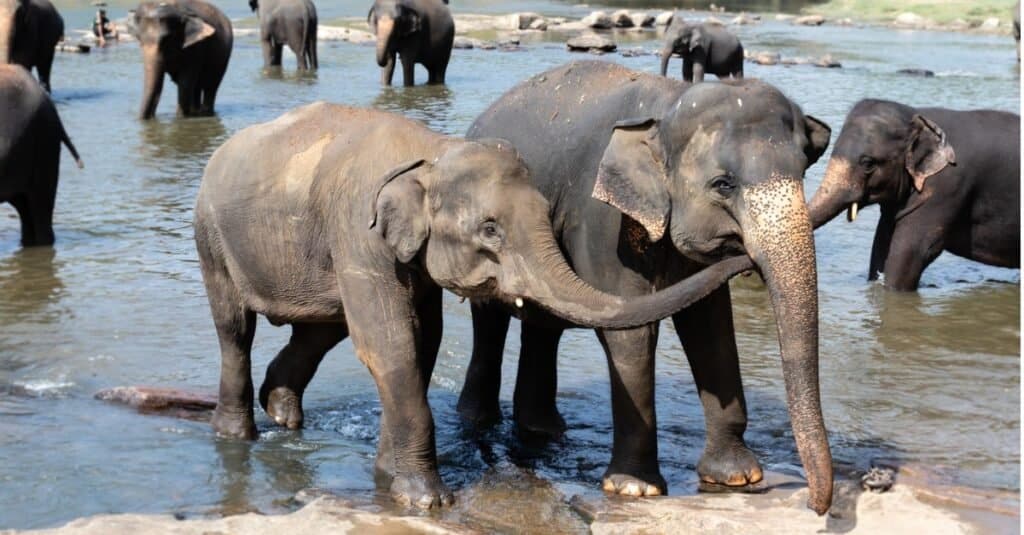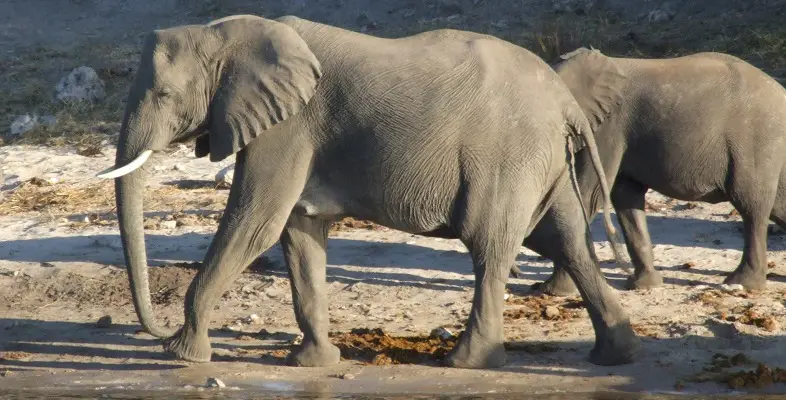No, elephants are not cold blooded. Elephants are warm blooded animals who maintain a constant body temperature.
Elephants, which are warm blooded animals, differ greatly from cold blooded creatures in terms of their body temperature regulation. Warm blooded animals, like elephants, have the ability to maintain a stable body temperature regardless of the external environment. This means that they can adapt to both warm and cold climates without their body temperature being affected.
In contrast, cold blooded animals, such as reptiles, rely on external heat sources to regulate their body temperature, making them highly dependent on their surroundings. Understanding the distinction between warm and cold blooded animals is crucial in comprehending the physiological processes that allow elephants to thrive in various habitats.

Credit: a-z-animals.com
Why Do Elephants Have Big Ears?
Elephants are known for their massive size and distinct features, and one of their most prominent characteristics is their large ears. Many people wonder why elephants have such big ears, and the answer lies in their need to regulate body temperature.
The Role Of Ears In Regulating Body Temperature
The unique size and structure of elephants’ ears serve a vital purpose in helping these magnificent creatures regulate their body temperature.
Elephants, like any other animal, have a natural body temperature that needs to be maintained within a specific range for their survival. However, living in warm climates can pose challenges in keeping cool, especially for such large animals.
The large surface area of an elephant’s ears allows for effective heat exchange with the environment. When the surrounding temperature rises, elephants face the risk of overheating. But thanks to their ears, they have a remarkable and energy-efficient cooling mechanism.
When an elephant feels hot, the blood vessels inside its ears dilate, allowing more blood to flow through. As the warm blood circulates close to the skin’s surface, it gets cooled down by the passing air, effectively reducing the elephant’s body temperature.
Adaptations To Warm Climates
Elephants have evolved specific physical adaptations to ensure their survival in warm climates.
In addition to their big ears, elephants possess other adaptations that aid in coping with warm climates. Their large size, for instance, helps them retain heat during cooler periods and effectively dissipate it when temperatures rise.
Furthermore, elephants have a special layer of fat that acts as an insulator, preventing excessive loss of body heat on colder days. This fat layer also provides protection against the scorching heat, keeping the elephant’s body temperature stable.
Their wrinkled skin also plays a crucial role in preserving moisture and minimizing water loss, as water scarcity is a common challenge in many hot regions where elephants are found.
In sum, elephants’ big ears are not merely a unique feature but a crucial element in their survival strategy. These magnificent creatures have evolved remarkable adaptations to thrive in warm climates, including their ingenious cooling mechanism and other physical characteristics that allow them to regulate their body temperature effectively.
Blood Circulation In Elephants
Elephants, despite their large size, are warm-blooded animals with an efficient blood circulation system. Their large hearts and unique blood vessels ensure that oxygen and nutrients are efficiently distributed throughout their bodies, allowing them to thrive in their diverse habitats.
The Importance Of Thermal Regulation
Elephants are remarkable creatures adapted to diverse environments, ranging from the scorching heat of savannahs to the chilly temperatures of high-altitude forests. Maintaining a stable body temperature is crucial for their survival, as extreme heat or cold can be equally detrimental to their well-being. The ability to regulate body temperature is essential for elephants, and their incredible blood circulation system plays a vital role in this process.How Blood Circulation Helps Elephants Regulate Body Temperature
Blood circulation in elephants is a complex and efficient system that facilitates thermal regulation in their bodies. This intricate network of blood vessels ensures that vital organs receive sufficient blood flow, while excess heat is released from the body through various mechanisms. Let’s delve into how blood circulation helps elephants maintain their body temperature within a healthy range. One of the main ways blood circulation aids in thermal regulation is through the dilation and constriction of blood vessels. When elephants are exposed to hot environments, their blood vessels expand or dilate, allowing more blood to flow through the skin’s surface. This process, known as vasodilation, promotes heat dissipation through the phenomenon of radiant cooling. As blood vessels near the skin expand, heat from the core of the body is transferred to the surface and released into the surrounding environment. Conversely, in colder climates, elephants’ blood vessels constrict or narrow, reducing blood flow to the skin’s surface and extremities. This constriction helps conserve heat within the body, preventing excessive heat loss and maintaining a stable core temperature. By restricting blood flow to non-essential areas, elephants can focus on keeping their vital organs warm and ensuring optimal physiological functioning. Additionally, blood circulation plays a critical role in distributing heat throughout an elephant’s body. Unlike humans and many other animals, elephants do not possess a specialized cooling organ like sweat glands. Instead, they rely on their extensive blood supply to transport heat from the core regions to the skin where it can be dissipated. This mechanism enables elephants to regulate their temperature effectively in varying climates. In conclusion, blood circulation in elephants is a remarkable adaptation that helps them regulate their body temperature. Through vasodilation and vasoconstriction, blood vessels facilitate heat dissipation or conservation, depending on the environmental conditions. This intricate system ensures that elephants can thrive in both hot and cold environments, and underscores their incredible ability to adapt to different climates. Understanding how elephants regulate their body temperature through blood circulation offers valuable insights into the fascinating world of these magnificent animals.Elephant Skin And Heat Regulation
One of the fascinating aspects of elephants is their ability to regulate body heat, even in the harshest of climates. This remarkable feat is due in large part to their unique skin. Let’s take a closer look at the properties of elephant skin and how it plays a crucial role in keeping these magnificent creatures cool.
The Unique Properties Of Elephant Skin
Elephant skin is incredibly thick, measuring up to 2.5 centimeters in some areas. This thickness helps to protect the animal from external injuries and predators. In addition to its thickness, elephant skin also contains a network of folds and wrinkles which further enhance its resilience.
The outermost layer of elephant skin, known as the epidermis, is covered with a tough, but surprisingly sensitive, layer of keratin. This layer not only acts as a physical barrier against the elements but also provides a degree of waterproofing, allowing elephants to stay submerged for long periods without their skin becoming saturated.
The Role Of Skin In Cooling The Body
Elephant skin serves as an effective cooling system that allows the animals to regulate their body temperature. The large surface area, combined with a unique network of blood vessels in their skin, enables elephants to dissipate excess heat efficiently.
When an elephant becomes overheated, it uses various strategies to cool down. One such strategy is thermal radiation. The extensive network of blood vessels close to the skin’s surface allows heat to radiate outwards, similar to how our bodies cool down when we sweat.
Additionally, elephants engage in mud baths and dust baths, both of which serve as natural cooling mechanisms. By coating themselves in wet mud or dry dust, elephants create a protective layer on their skin. As the mud or dust dries, it absorbs heat from the body, further aiding in temperature regulation.
| Properties | Benefits |
|---|---|
| Thick skin | Protects against injuries and predators |
| Wrinkles and folds | Enhances skin resilience |
| Keratin layer | Acts as a physical barrier and provides waterproofing |
| Large surface area | Facilitates efficient heat dissipation |
| Network of blood vessels | Aids in thermal radiation and cooling |
In conclusion, elephant skin is a marvel of nature. Its thickness, folds, and wrinkles, combined with a tough outer layer of keratin, provide excellent protection and help in regulating body temperature. The intricate network of blood vessels close to the surface allows for effective heat dissipation and thermal control. Understanding the complex heat regulation mechanisms of elephants gives us a deeper appreciation for these magnificent creatures and their ability to thrive in diverse environments.
The Myth Of Cold-blooded Elephants
When it comes to the animal kingdom, there are a plethora of fascinating facts and misconceptions that circulate. One such myth revolves around elephants and their temperature regulation. While it may be tempting to assume that elephants are cold-blooded creatures, the truth tells a different story. Let us debunk this misconception and uncover the truth behind elephant thermoregulation.
Debunking The Misconception
The belief that elephants are cold-blooded likely stems from their enormous size and slow movements. However, this assumption couldn’t be further from reality. Contrary to popular belief, elephants are actually warm-blooded animals.
| Common Misconception | Reality |
|---|---|
| Elephants are cold-blooded. | Elephants are warm-blooded. |
This misconception may have arisen due to the misconception that all large reptiles are cold-blooded. But elephants, although amazingly large creatures, are mammals, not reptiles. Similar to other mammals, such as humans, elephants have an internal temperature regulation system that keeps their bodies warm, even in colder environments.
The Truth Behind Elephant Thermoregulation
Elephants have various methods for maintaining their body temperature, a process known as thermoregulation. One of the main strategies elephants employ is their thick layer of subcutaneous fat. This fat layer acts as an insulator, keeping the elephant’s body warm by trapping heat. In addition to their fat, elephants also have a dense network of blood vessels close to the surface of their skin. This allows for effective heat exchange with the external environment.
- Elephants have a thick layer of subcutaneous fat, which acts as insulation.
- Elephants have a dense network of blood vessels close to the skin’s surface.
Moreover, elephants have large ears that serve another crucial role in their thermoregulation process. These ears are equipped with a vast network of blood vessels that help dissipate excess heat from the elephant’s body. By flapping their ears, elephants can increase airflow around these blood vessels, cooling down their bodies when needed.
In conclusion, the belief that elephants are cold-blooded is nothing more than a common misconception. Elephants are warm-blooded creatures that possess unique thermoregulatory adaptations to maintain their body temperature. Understanding the truth behind elephant thermoregulation allows us to appreciate and admire these majestic animals even more.
How Do Elephants Stay Cool?
Elephants stay cool by using various techniques such as flapping their ears, spraying water on their bodies, and taking mud baths to regulate their body temperature. Despite being warm-blooded mammals, elephants have developed effective ways to beat the scorching heat.
The Behavioral Strategies Elephants Employ For Cooling
Elephants are fascinating creatures that have several interesting ways to beat the heat. When it comes to staying cool, these gentle giants employ a range of behavioral strategies to regulate their body temperature and avoid overheating. Let’s explore some of the ways elephants stay cool in their natural habitat.
Water, Mud, And Dust Bathing
One of the most noticeable ways elephants cool down is by indulging in water, mud, and dust bathing. These activities not only help the elephants stay cool but also provide them with a protective barrier against harmful sun rays and insects. Elephants are proficient swimmers, and they take full advantage of water bodies found in their environment, such as rivers and lakes. They often submerge their bodies in water, using their trunks as snorkels to breathe. This rejuvenating and refreshing activity ensures that elephants are able to reduce their body temperature effectively.
Additionally, elephants coat themselves in mud and dirt, which plays a crucial role in regulating their body temperature. The thick layer of mud helps to insulate their bodies against the scorching sun, preventing them from overheating. Mud is an excellent coolant as it evaporates slowly, providing a cooling effect on the elephant’s skin. Interestingly, this mud coating also acts as a natural sunscreen that protects their sensitive skin from sunburn and pesky insects.
Apart from mud bathing, elephants also engage in dust bathing. They throw dust and dirt over their bodies using their trunks, ensuring it covers every nook and cranny. Dust bathing helps elephants to remove excess moisture and keep their skin dry and cool. The dust particles also act as a protective barrier, preventing parasites and insects from bothering the elephants.
Frequently Asked Questions Of Are Elephants Cold Blooded
Is It True That Elephants Are Cold-blooded?
No, elephants are not cold-blooded. They are warm-blooded mammals, just like humans, and have the ability to regulate their body temperature.
How Do Elephants Stay Warm In Colder Climates?
Elephants have a thick layer of fat and a dense coat of hair that helps them stay warm in colder climates. They also huddle together for warmth and can generate body heat through physical activity.
Can Elephants Feel The Cold?
Yes, elephants can feel the cold. They are sensitive to temperature changes and may seek shelter or utilize natural resources to protect themselves from extreme cold conditions.
Do Elephants Migrate To Warmer Regions During Winter?
No, elephants do not typically migrate to warmer regions during winter like some other animals. They are able to adapt to various climates and have strategies to cope with colder weather.
How Do Elephants Protect Their Young From The Cold?
Elephants protect their young from the cold by keeping them close within the herd, providing warmth and shelter. The adults may also use their bodies to shield the calves from harsh weather conditions.
Do Elephants Have Any Natural Adaptations For Cold Weather?
Yes, elephants have natural adaptations for cold weather. Their large size and body mass help to retain heat, and their long trunks act as a radiator, allowing them to regulate their body temperature effectively.
What Are Some Challenges Elephants Face In Cold Environments?
In cold environments, elephants may face challenges such as limited food availability, difficulty in finding water sources due to freezing conditions, and the risk of hypothermia if adequate shelter is not available.
Conclusion
To sum up, elephants are not cold-blooded creatures. Despite their massive size, these gentle giants possess an incredible ability to regulate their body temperature and adapt to various climates. Their thick skin and behavioral adaptations enable them to keep warm or cool down as needed.
Understanding the remarkable physiology of elephants allows us to appreciate their resilience and adaptability in different environments. So, next time you encounter an elephant, remember that they are warm-blooded beings, capable of withstanding both the scorching heat and freezing cold.

